-
PDF
- Split View
-
Views
-
Cite
Cite
Aung Y. Oo, Antony D. Grayson, Abbas Rashid, Effect of training on outcomes following coronary artery bypass graft surgery, European Journal of Cardio-Thoracic Surgery, Volume 25, Issue 4, April 2004, Pages 591–596, https://doi.org/10.1016/j.ejcts.2003.12.012
Close - Share Icon Share
Abstract
Objective: We examined our coronary artery bypass surgery (CABG) experience to assess the effect of training on mortality and morbidity outcomes. Methods: Between April 1997 and September 2002, 5678 consecutive patients underwent isolated CABG. Five hundred and fifty-five (9.9%) were performed by trainee surgeons. Multivariate logistic regression was used to assess the effect of training on adverse outcomes, while adjusting for patient and disease characteristics (treatment selection bias). Cox proportional hazards analysis was used to adjust Kaplan–Meier survival curves. Treatment selection bias was controlled for by constructing a propensity score from core patient characteristics including the additive EuroSCORE. The propensity score was the probability of CABG performed by trainee, with a C-statistic of 0.79, and was included along with the comparison variable (trainee vs Consultant) in a multivariable analysis of outcome. The propensity score is used as the sole variable for adjustment due to the low number of events, providing a more complete risk adjustment. Results: CABG procedures performed by trainee surgeons were less likely to be female, hypertensive, obese, triple-vessel disease, redo and emergency cases. Also, trainee surgeons were less likely to operate on patients with cerebrovascular disease, renal dysfunction, and previous myocardial infarctions, prior gastrointestinal surgery, and poor left ventricular ejection fraction. The additive EuroSCORE was 2.9 in trainee cases compared to 3.5 in Consultant led cases (P<0.001). Crude outcomes were significantly better in trainee CABGs due to selection bias. In-hospital results were no longer significantly different between both groups after adjusting for the propensity score. The adjusted freedom from death in the trainee cases at 30 days, 1, 2, 3, and 4 years was 98.1, 96.2, 94.7, 93.2 and 91.8%, respectively, compared to 97.9, 95.7, 94.1, 92.3 and 90.8% for the Consultant led cases (P=0.53). Conclusions: After adjusting for case-mix, with careful case selection, training does not adversely affect the early and mid-term outcomes of CABG.
1 Introduction
There is a growing difficulty within the National Health Service to balance the quality of the services provided with the need for increased surgical training [1]. With surgical performance under constant scrutiny and the demand for more accountability, some Consultant surgeons may be inclined to reduce the number of operations they allow a trainee to lead. However, this is at odds with the training requirements of junior surgeons. Therefore, a better understanding of the effect trainee surgeons have on short- and mid-term outcomes is required.
Several studies have been published recently examining the impact of training on outcomes in cardiac surgery. These have however been on relatively small numbers, around 3000 procedures [2–4]. Jenkins and colleagues, in a study involving 6037 cardiac surgery operations, published in 2001 their experience of surgical training and concluded that with appropriate case selection, training in cardiac surgery can achieve good results [5].
We aimed to assess the effect of training in coronary artery bypass graft (CABG) surgery at our institution on in-hospital outcomes and mid-term survival, while adjusting for differences in patient and disease characteristics.
2 Methods
2.1 Patient population and data
We performed a retrospective study on a total of 5678 consecutive patients undergoing CABG surgery between 1st April 1997 and 30th September 2002 at the Cardiothoracic Centre, Liverpool. Patients undergoing CABG that was combined with a heart valve repair or replacement, resection of a ventricular aneurysm or other surgical procedure were not included.
All data were collected prospectively during the patient admission as part of routine clinical practice. Methods of data collection and definitions have been previously published [6] and are available from www.nwheartaudit.nhs.uk. Data were collected on the following variables: age, sex, body mass index, urgency of operation, angina class, smoking, diabetes, hypercholesterolaemia, hypertension, previous myocardial infarctions, peripheral vascular disease, cerebrovascular disease, respiratory disease, renal dysfunction, prior cardiac surgery, prior gastrointestinal surgery, as well as the extent of coronary disease, and left ventricular ejection fraction. The Procedure details collected during the operation included name and grade of first operator, number of grafts, off-pump surgery and use of the left internal mammary artery (LIMA).
During a junior surgeons training at the centre, they would be expected to perform tasks such as suturing anastomoses or harvesting the LIMA on a regular basis before taking on cases as first operator. All cases were a trainee was first operator would be closely assisted (sometimes in the form of guidance) by the Consultant in charge of the case. However, a trainee in their final year of training would gradually be given more independence during the procedure. It is important to stress that at all times; a Consultant cardiac surgeon would be available in case of difficulties.
The in-hospital outcome measures for this study were mortality, stroke, peri-operative myocardial infarction, acute renal failure, deep sternal wound infection, re-exploration for bleeding, atrial arrhythmia, gastrointestinal complications, and duration of mechanical ventilation. Follow-up data included mid-term mortality.
In-hospital mortality was defined as death within the same hospital admission regardless of cause. All patients transferred from the base hospital to another hospital were followed up to confirm their status at discharge. Post-operative stroke was defined as a new focal neurological deficit and comatose states occurring post-operatively that persisted for >24 h after its onset and was noted before discharge. We excluded confused states, transient events and intellectual impairment from our study to avoid any subjective bias. Post-operative myocardial infarction was defined as a new Q-wave post-operatively in two or more contiguous leads on an electrocardiogram or significant rise in post-operative cardiac enzymes combined with haemodynamic and echocardiographic signs of myocardial infarction. Acute renal failure was defined as patients requiring post-operative dialysis support. Re-exploration for bleeding was defined as bleeding that required surgical re-operation after initial departure from the operating theatre. Criteria for defining deep sternal wound infection were in accord with the published evidence-based guidelines by the Centres for Disease Control and Prevention [7]. Post-operative atrial arrhythmia was defined as the occurrence of new atrial arrhythmia in the absence of pre-operative persistent or paroxysmal atrial arrhythmias. Definitions for gastrointestinal complications were in line with The Society of Cardiothoracic Surgeons of Great Britain and Ireland minimum dataset and included gastrointestinal bleeding, pancreatitis, ischaemic bowel, and perforation [8].
2.2 Patient follow-up
Patient records were linked to the National Strategic Tracing Service (NSTS), which records all deaths in the United Kingdom. To establish current vital status, patients were matched to the NSTS based on patient name, National Health Service unique number, date of birth, gender, and postcode.
2.3 Statistical methods
Due to non-normality of data, continuous variables are shown as median with 25th and 75th percentiles. Categorical variables are shown as a percentage. Comparisons were made with Wilcoxon rank sum tests and χ2-square tests as appropriate. The European System for Cardiac Operative Risk Evaluation (EuroSCORE) was calculated to assess overall differences in patient case-mix [9]. Logistic regression was used to adjust in-hospital outcomes for differences in patient and disease characteristics (treatment selection bias) [10]. Deaths occurring as a function of time were described using the product limit methodology of Kaplan and Meier [11]. Cox proportional hazards analysis was used to calculate adjusted hazard ratios (HR) and to risk adjust the Kaplan–Meier survival curves [12].
Treatment selection bias was controlled for by constructing a propensity score, otherwise known as a balancing score [13]. The propensity score was the probability of undergoing CABG led by a trainee surgeon, and was constructed from core patient characteristics and the additive EuroSCORE (C-statistic=0.79) [14]. Once the propensity score is constructed for each patient, there are three ways of using the score for comparisons: matching, stratification, and multivariable adjustment. We decided to use multivariable adjustment because matching would have reduced the study size and stratification can be difficult to interpret. The propensity score is then included along with the comparison variable (trainee or Consultant) in a multivariable analyses of outcome producing adjusted odds ratios as shown in Table 5 . The propensity score adjusts for the treatment selection bias, which is evident in Table 2 , between one group vs another. An example of the calculation of the propensity score is given at the bottom of Table 5. Using a propensity score as the sole means for adjusting outcomes was preferable due to the low number of events in our study and provides better adjustment for those factors driving treatment selection; the overall effect is more complete risk adjustment [13]. In all cases a P-value <0.05 was considered significant. All statistical analysis was performed retrospectively with SAS for Windows Version 8.2.

Post-operative data based on first operator, adjusted for the propensity score
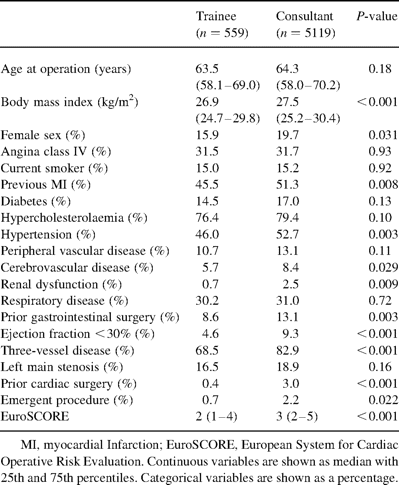
3 Results
During the study period, 559 (9.9%) patients underwent CABG led by a trainee surgeon, compared to 5119 (90.1%) led by a Consultant. The proportion of CABG procedures led by a trainee was 11.8% in the financial year of 1997/1998, compared to 10.3% in 2001/2002 (P=0.29).
Overall, there were 17 trainee surgeons during the study, which led on average 32 procedures (minimum 8 and maximum 119). For trainee surgeons who led less than 50, between 50 and 100, and more than 100 procedures, the respective in-hospital mortality was 0, 0.5, and 1.7% (P<0.05). This increase in mortality was explained by an increase in risk, according to the EuroSCORE for the three groups, which was 1.2, 1.8, and 2.8%, respectively (P<0.05). The relationship between year of training and in-hospital mortality is shown in Table 1 .
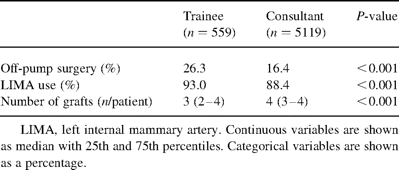
Table 2 lists the patient and disease characteristics based on first operator. CABG procedures performed by trainee surgeons were less likely to be female, hypertensive, obese, triple-vessel disease, redo and emergency cases. Also, trainee surgeons were less likely to operate on patients with cerebrovacular disease, renal dysfunction, previous myocardial infarctions, prior gastrointestinal surgery, and poor ejection fraction.
Operative details on off-pump surgery and the use of LIMA, along with the number of grafts are shown in Table 3 .

Table 4 shows that crude in-hospital outcomes were significantly better in trainee CABGs. After taking into account the differences in case-mix, by adjusting for the propensity score, the results of trainee surgeons were neither significantly better nor worse than Consultant surgeons (Table 5). The factors which made up the propensity score are shown at the bottom of Table 5.
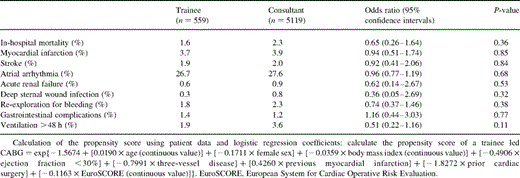
Five hundred and fifty-nine (9.8%) deaths occurred during the follow-up period. The total follow-up was 16 335 patient-years, with a mean average of 2.9 years (standard deviation 1.6 years). The number of patients at risk of death during each year of the follow-up are shown in Fig. 1 . The crude HR of mid-term mortality for trainee cases was 0.69 (P=0.041). Freedom from death in the trainee cases at 30-days, 1, 2, 3, and 4 years was 99.3, 97.8, 96.2, 95.1, and 93.3%, respectively, compared with 97.7, 95.4, 93.7, 91.8, and 90.3% for the non-trainee cases (Fig. 1).
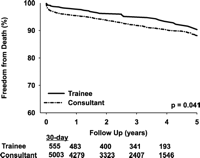
After adjustment with the propensity score, the adjusted HR of mid-term mortality for trainee cases was 0.89 (P=0.53). The adjusted Kaplan–Meier survival curves are shown in Fig. 2 . The adjusted freedom from death in the trainee cases at 30-days, 1, 2, 3, and 4 years was 98.1, 96.2, 94.7, 93.2, and 91.8%, respectively, compared with 97.9, 95.7, 94.1, 92.3, and 90.8% for the non-trainee cases.
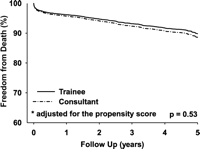
Adjusted survival following coronary artery bypass surgery, adjusted for the propensity score.
4 Discussion
The European working times directive is reducing junior doctors' hours, thus leading to less exposure and training opportunities. Moreover, increasing public scrutiny of individual surgeons' results has led to greater caution among senior surgeons to provide training.
There is a general belief among clinicians that trainee surgeons are associated with increased morbidity and a prolonged hospital stay, and therefore increased hospital costs. Due to this, junior surgeons are often given easier cases during their training, while the Consultants more often than not deal with the more complex procedures [3]. Stoica and co-workers point out that when two patients have the same EuroSCORE, the Consultant is more likely to choose to operate on the patient with less favourable anatomy or with other co-morbid factors not included in the EuroSCORE [2].
Our study demonstrates the clear process of case selection with the patient characteristics between trainee and Consultant surgeons being vastly different in many areas. CABG procedures performed by trainee surgeons were less likely to be female, triple-vessel disease, poor ejection fraction, redo and emergency cases. Also, co-morbid factors were significantly less frequent in trainee cases, producing a significantly lower risk score as measured by EuroSCORE. On average one additional graft was required during the procedure for Consultant surgeons, which again confirms the complex nature of the operations they choose to perform.
This obvious difference in case-mix leads to crude outcomes being significantly lower in procedures led by trainee surgeons compared to Consultants. This leads to erroneous conclusions, such as ‘trainee operating had an apparent protective effect’ [2]. Does this mean trainee surgeons are better at performing CABG? The straightforward answer is not at all. In fact such crude comparisons are misleading, and could quite easily mask poor performance in our junior surgeons.
The planned publication of crude mortality rates in CABG in the United Kingdom [15] adds further complexity to the question of training as Consultants will become more and more inclined to lower the number of procedures under their care that they allow trainee surgeons to lead, as a handful of deaths could have serious consequences. Also, with increased scrutiny of surgical performance and need for accountability not only in the United Kingdom but across the world, it is important to regularly audit performance among trainee surgeons, while taking into account differences in case-mix.
Surgical training in cardiac surgery is increasingly demonstrated as safe [2–5,16]. Jenkins and colleagues concluded that with the appropriate selection of cases, the performance of trainees is good [5]. The Department of Veterans Affairs cooperative study on valvular heart disease, found that the operative mortality of trainee cases was not significantly higher after adjusting for risk factors [16]. Training in off-pump CABG, a technique which is becoming increasingly more popular [17], has also been shown to be safe with acceptable results [18,19]. In our series, we have found that 26.3% of trainee cases are performed without cardiopulmonary bypass.
In this large, recent series of CABG patients, we have shown that after adjusting for case-mix, with careful case selection, training does not adversely affect the early and mid-term outcomes of CABG. In-hospital morbidity and mortality results were similar between Consultant and trainee surgeons, but more importantly, the adjusted survival at 4-years was also not significantly different. This highlights that the quality of surgery provided are similar, as long as adequate training and supervision are given to trainees.
Our study has also highlighted that the in-hospital mortality rates increase with the number of cases performed by trainee surgeons, which is closely linked to the year of training. This increase in mortality is due to an increase in the complexity of the cases that a trainee takes on as first operator over time. At no time does the mortality exceed what is expected according to the patients risk profile, as measured by the EuroSCORE.
There are several limitations in our study. Firstly it is an observational report; however, we have adjusted for differences in patient characteristics by using a propensity score, which was included in the multivariable analyses. Propensity score adjustment is no substitute for a properly designed randomised control trial (RCT), on the other hand, retrospective comparisons with propensity score adjustment are more versatile and may be more widely acceptable than RCTs.
Another limitation is the fact that the trainee results will probably reflect part of the Consultants performance due to the assistance they would have given to the junior surgeon. Unfortunately we cannot quantify the full extent of involvement by the Consultants in this retrospective data, although this is now something we are collecting prospectively since carrying out this study.
A final limitation is that we have only examined survival as a mid-term outcome. Other mid-term results, such as recurrence of angina, additional revascularisation (either surgical or percutaneous), and quality of life were not available at the time of this study, but will be of interest in the future.
In conclusion, after accounting for differences in patient characteristics, training under Consultant supervision in coronary artery bypass surgery is safe with acceptable short- and mid-term results.
We would like to acknowledge the co-operation given to us by all the Consultant Cardiac Surgeons at the Cardiothoracic Centre-Liverpool: Mr JAC Chalmers, Mr WC Dihmis, Mr BM Fabri, Miss EM Griffiths, Mr N Mediratta, Mr RD Page, Mr DM Pullan, Mr A Rashid, and Mr WI Weir. We would also like to thank Janet Deane, who maintains the quality and ensures completeness of data collected in our Cardiac Surgery Registry.
Dr B. Buxton (Heidelberg, Victoria, Australia): Risk adjustment using a national death index is a very powerful tool. Two hypothetical questions.
One is, how do you define an outlier, that is, when does a cardiothoracic surgical trainee not meet your expectation? And secondly, what action do you take if you find someone outside the “loop”?
Mr Oo: We all have to face those kinds of questions. We just presented the workload and the actual results and what is actually going on the ground during that period. So we didn't look into the issue of outliers at the time, but obviously this kind of tool will help us in the future in identifying outliers in early stage training so that that will help for their future training, intensive training, or maybe to change their specialty.
Dr Buxton: Mr Chairman, we have the same issues, and we haven't defined how to handle those particular problems, but they are difficult.
Dr S. Hagl (Heidelberg, Germany): You showed us the mortality over time in form of a late follow-up. Do you have other data on that? I mean, do you have, let's say, seen infarctions, reinfarctions, readmissions to hospitals for angina?
Mr Oo: This is what I mentioned in the future works and the limitation of the study.
Dr Hagl: But you don't have it at the moment?
Mr Oo: We don't have it at the moment, that's right. And obviously we need to take into consideration also the time period where you have a mixture of trainees and a mixture of surgeons; the change period will change over.
Mr B. Bridgewater (Manchester, UK): I have some concerns about this sort of study. This is a retrospective analysis of prospectively collected data, and one of the things that happens in real life is that if a trainee is getting into some mischief with a case the consultant will take over, and the way the data will then be collected, I assume, is that it will go down as a consultant case rather than a trainee case. For this study to have any meaning, I think the data needs to be analysed on an intention to treat basis. Have you any comments on that?
Mr Oo: We always face this process during training, because at any given stages, we have, say, six trainees with different stages, so year one and year two trainees will need more assistance compared to year four, year five and year six trainees. So this study is encouraging us to train more and showing this is safe, and then also shows us the trainers have selected the cases well and train the juniors well to achieve similar results. And I admit there will be always difficulty and then get the study completely right and hundred percent sure that it is specific.
Dr H. Dasmahapatra (Calcutta, India): It is nice to see that your trainees are doing a better job. But my one question is, does your study involve OPCAB or conventional cardiopulmonary bypass and CABG?
Mr Oo: I can tell you out of these 559 patients, which constitute about 9.9% of the coronary work done in the period, and of that 9.9, 26.3% were OPCAB.
Dr Dasmahapatra: And have you compared the data of OPCAB, trainee surgeons and the consultant surgeons, their results?
Mr Oo: We can't discuss that at the moment because we haven't looked into detailed analysis of OPCAB because the numbers would be lower.
References
- myocardial infarction
- obesity
- left ventricular ejection fraction
- hypertension
- coronary artery bypass surgery
- cerebrovascular disorders
- kidney failure
- consultants
- risk adjustment
- morbidity
- mortality
- triple vessel disease
- gastrointestinal surgical procedures
- survival curve
- european system for cardiac operative risk evaluation




